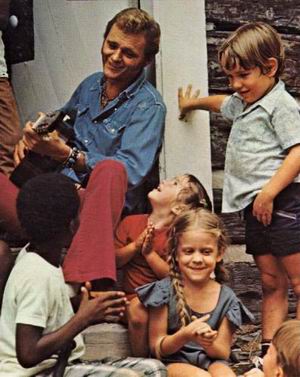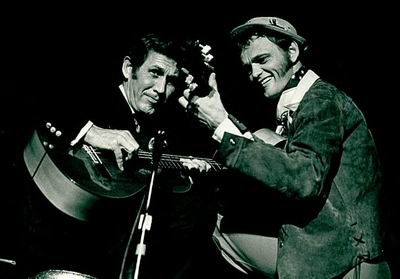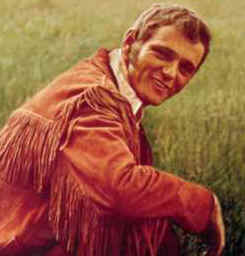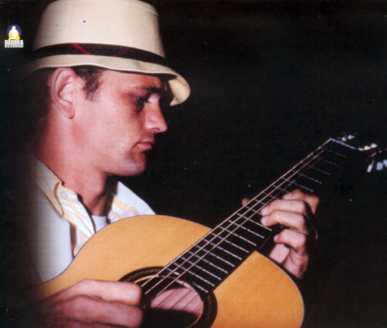🎸 Jerry Reed
The Guitar Man - Fingerpicking Legend and Exceptional Showman

Jerry Reed Hubbard (1937-2008)
🎸 The Guitar Man - Fingerpicking Legend
Jerry Reed Hubbard (March 20, 1937 - September 1, 2008) was a fingerpicking guitar virtuoso, legendary songwriter, and exceptional showman. Author of "Guitar Man" and "When You're Hot You're Hot," he marked the history of country music and American cinema.
⭐ The Emergence of a Legend (1970s)
The first time Jerry Reed's name was on everyone's lips was in the 1970s. That was the year he ventured into pop and country records with "Amos Moses."
There were several TV appearances, several magazine articles, and it was discovered that not only was he the author of Elvis Presley's hits "Guitar Man" and "US Male", but he also played guitar on these tracks.
⏰ A 16-Year Success
Jerry didn't have what you could call an immediate success. He had been recording since 1954, without great fortune. It took him years to develop the personality that emerged in his records. It had taken him only sixteen years.

🔥 "When You're Hot, You're Hot" - The Peak

The following summer, "When you're hot, you're hot" was playing on all country and pop radio stations. Glen Campbell programmed Jerry in his TV show, and when Glen Campbell went on summer vacation, Jerry replaced him with the "Jerry Reed, When you're hot, you're hot Hour".
If anyone was hot that summer, it was Jerry Reed.
🎭 The Meditative Side
Later, Jerry developed the same personality in movies. He told magazines he was the luckiest man on Earth because he was paid to play, which wasn't entirely true. There's a quieter, more meditative side to Jerry Reed.
You can feel it through his ballads and in the years spent studying guitar. You don't become that good simply by wishing it. Jerry practiced a lot: up to sixteen and eighteen hours a day, for years.
🌟 Discovery by Bill Lowery (1954)

Jerry was discovered by Bill Lowery, one of the promoters and agitators in the Atlanta music world. In 1954, Lowery, who worked at "Uncle Eb Brown," conducted a radio show on Georgia State RTech radio station WGST.
Another local singer told him about Jerry Reed, and Jerry came to sing a song of his composition called "Aunt Meg's Wooden Leg".
🎯 Capitol Records
Lowery got Jerry a spot in a show with Tommy Collins and Faron Young, two artists signed to Capitol Records. Capitol R.'s artistic director, Ken Nelson, was in the audience that night.
"I've never seen so much stage presence in such a young boy", he said later. Lowery asked Ken Nelson if he was interested in signing Jerry and Ken replied: "You bet!"
🎖️ First Recordings and Military Service
Jerry was taken to Nashville for the annual Deejays convention and Nelson recorded Jerry there. They tried country music - in fact, Johnny Cash covered Jerry's first single, "If the Good Lord Willing And The Creeks Don't Rise", on his first album.
Later, they tried Rock'n Roll. Nothing came. In Jerry's oldest interview, in 1955, he talked about doing theater or cinema, and set no limits for himself.
⚔️ Military Period
Four years, ten singles and no hits later, Jerry was dropped by Capitol. He went to the army for two hard years and while he was there, he wrote a song for Brenda Lee, "That's All You Gotta Do", which became the B-side of "I'm Sorry".
🏙️ Moving to Nashville (1962)
After he left the army, he wrote three singles for NCR Bill Lowery records, and Columbia Records in Nashville signed him in 1960. He had some ephemeral pop hits in 1962, "Good Night Irene" and "Hully Gully Guitar", but the time he hit the top was when Porter Wagner brought his song "Misery Loves Company" to the top of the country charts.
Nashville was becoming the place to be. Jerry could pitch his songs and the scene was opening up to him. One of his Atlanta buddies, Ray Stevens, was already working in many sessions there, and asked Jerry to come and give it a try.
👥 Family Life
Jerry Kennedy from Mercury records liked what he heard and promised work. So in 1962, Jerry and his wife, Priscilla Mitchell moved. Priscilla sang as a backup singer for a while, and Jerry Kennedy signed her to Mercury. She got her first hit in 1965 - six years before Jerry Reed - in a duet with Roy Drusky on "Yes, Mr Peters".

🎸 Prolific Recording Sessions
For Jerry, the first years following his move to Nashville involved only recording sessions, sessions and more sessions. He held the lead guitar in most of Bobby Bare's recordings, including "Detroit City" and "Four Strong Winds".
🎸 The Collaboration with Chet Atkins (1964)
In 1964, with a career as a session guitarist behind him, Jerry asked to leave Columbia to join his hero, Chet Atkins, then artistic director at RCA in Nashville.
Chet had already recorded one of Jerry's productions, "Scarecrow", in early 1962, and had explored together the mysteries of fingerstyle.
😰 The First Audition
Jerry often told the story of the first time he played in the office in front of Chet Atkins. It took him fifteen minutes to get his bearings, his hands shaking too much, and yet, Chet is not an intimidating person.
🎵 "Guitar Man" - The Turning Point (1966)
Chet didn't sign him as just another picker. He thought he could produce hits with him. During the first two years at RCA, Jerry released country records that "sounded" like any other country record.
💡 Chet's Advice
So, as he tells it himself:
"One day, Chet said to me: You should stop recording this way, because it's not in your feeling. It's not your way of being. Your way of being is your way of being when you take your guitar in my office and play your licks and sing your songs."
In 1966, "Guitar Man", the first real single made by the real Jerry Reed, as he truly was, climbed to 53rd place in the country charts. From there, his tracks became increasingly successful, until "Amos Moses" topped both pop and country in 1970.
That's when everyone recognized Jerry Reed's "lightning" success. It had taken him only sixteen years.
👑 The Collaboration with Elvis Presley
Slowly, the studio sessions ended. The last artist he worked for was Elvis Presley. At Elvis's insistence, Jerry was pulled from a fishing trip to play guitar on "Guitar Man". After that, Elvis "borrowed" "U.S. Male" from him.
Later, well after Jerry was a star in his own right, he returned to lend his guitar playing to two other Elvis tracks "A Thing Called Love" and "Talk About The Good Time".
🎸 Post-Elvis Legacy
Then, after Elvis's death, producer Felton Jarvis brought Jerry back to the studio to redo his solo part in "Guitar Man." The idea was for Jerry to double a vocal duo which seemed criminal in the eyes of the businessmen. The new version placed in the top 30. Elvis was still lasting.

🏆 "Me and Jerry" - First Grammy (1970)
Jerry found comfort in instrumentals on most albums and some LPs. In 1970, he won a Grammy for "Me and Jerry", the first duo album with Chet Atkins.
👨👦 Father-Son Relationship
Chet and Jerry were somewhat like a father and his son. To some extent, anyone who played country guitar fingerstyle had to go through Chet Atkins, but while he admired Chet, Jerry was looking for something different.
His style was based on riffs, like on old Ray Charles records. "There are things I discovered by chance, by digging and exploring" Jerry said.
🔧 "The Claw" - Technical Innovation
Throughout these years, several of his compositions bear the imprint of other pickers, but "The Claw" is one of the pieces that guitarists study because of the way Jerry integrates rhythm and lead. Another Chet protégé, Lenny Breau, rewrote it in minor mode.
Later, with the same integration ability that made him one of the best fingerstyle guitarists, Jerry taught himself guitar solos with the same success.
🎬 Film Career with Burt Reynolds
For most of his fans, Jerry playing guitar was the cherry on the cake. They identified him as the good old smart guy, and that's why the producers of "W.W. And The Dixie Dance Kings" wanted him to come to Nashville to audition.
Jerry had refined his style and had no problem transposing it to the screen. He and Burt Reynolds created a kind of on-screen chemistry. That's why the producers renewed the tandem in "Gator".
🏁 "Smokey and the Bandit"
Then came "Smokey and the Bandit", the 11th biggest Hollywood success in '77 and the second biggest success just behind "Star Wars." No need to look for which of the two was cheaper to produce.
Jerry is often asked where this ease of slipping into film came from. "I tend to believe that things happen because they have to happen", he told journalist Bob Allen, adding wisely: "you can be as good as the best part of yourself that you want to show".

🌅 End of Career and Legacy

In 1984, after twenty years with the same label, Jerry parted ways with RCA. He became more discreet in his last fifteen years but continued to travel the roads to participate in musical events that were close to his heart.
He always said he listened little to the radio, which is probably true. And if he glances at the news, he will be forgiven for thinking that one country singer today looks like another country singer.
⭐ A Unique Artist
That's what can never be said about him. He had a long apprenticeship, but when he was ready, he looked like no other: he was Jerry Reed Hubbard.
Jerry Reed passed away on September 1, 2008 at the age of 71, leaving an immense legacy in the world of fingerpicking guitar, country songwriting and entertainment.
💿 Essential Discography
🌟 Classic RCA Albums
- "Me and Jerry" (1970) - Grammy Award
- "When You're Hot You're Hot" (1971)
- "The Best Of Jerry Reed" (1992)
🎬 Soundtracks
- "W W And The Dixie Dancekings" (1975)
- "Gator" (1976)
- "Smokey And The Bandit" (1977)
🏆 Essential Hits
- "Guitar Man" - For Elvis
- "Amos Moses" - #1 country/pop
- "When You're Hot, You're Hot"
- "The Claw" - Instrumental masterpiece
🔗 Découvrir Jerry Reed Hubbard
📍 Guitar Pickers Association
Jerry Reed embodies the innovative spirit and artistic versatility that Guitar Pickers Association defends. His unique approach blending fingerpicking technique and showmanship inspires guitarists to develop their own musical personality.
